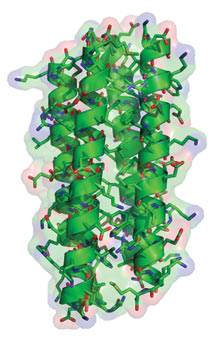From the Labs: Biomedicine
Artificial Proteins
A synthetic protein built from scratch can carry oxygen, mimicking blood

Source: “Design and engineering of an O(2) transport protein”
P. Leslie Dutton et al.
Nature 458: 305-309
Results: Scientists at the University of Pennsylvania have designed and built a protein that can transport oxygen. The protein is much simpler than the oxygen-carrying proteins found in nature, and the process that they used demonstrates a new method for making novel proteins.
Why it matters: A more complex version of the protein could eventually be used to create artificial blood. The research also illustrates the effectiveness of the new design process, which could be used to engineer other proteins that improve on the efficiency of important biological functions–or proteins with entirely new functions.
Methods: The design process begins with a simple artificial protein that the researchers gradually change until it performs a desired function. To make the oxygen-binding protein, the researchers used three amino acids, the building blocks of proteins, to create four novel helix-shaped structures that they assembled into a bundle. Then they replaced some of these amino acids with ones that would help the bundle incorporate a chemical group called a heme, which can bind oxygen molecules. They added other amino acids to help make the protein structure flexible enough to open, letting the heme bind oxygen, and then close, protecting the oxygen from water.
Next steps: Researchers plan to engineer artificial functional proteins that incorporate light-harvesting pigments to capture solar energy.
Better MRI
A new method of modifying molecules could improve medical imaging
Source: “Reversible interactions with para-hydrogen enhance NMR sensitivity by polarization transfer”
Simon B. Duckett et al.
Science 323: 1708-1711
Results: A novel method of modifying the magnetic properties of molecules, developed by researchers at the University of York, in the United Kingdom, makes magnetic resonance imaging (MRI) a thousand times more sensitive. The technique provides a way to use a broad range of drugs and antibodies to label specific tissues for medical imaging.
Why it matters: If proved safe and effective in humans, the new technique would lead to new diagnostic and treatment applications for MRI. An antibody designed to stick to a tumor could be used for cancer screening, for example.
Methods: Researchers have known that hydrogenation reactions can be used to modify molecules with a form of hydrogen called parahydrogen, which changes their magnetic properties in a way that greatly improves MRI results. But this process works with only a few types of molecules. The researchers developed a way to temporarily link the parahydrogen to various organic molecules using an intermediary chemical complex, without causing them to undergo any chemical change. They showed that the process enhances the magnetic signal of a variety of organic molecules, including chemicals widely used in making pharmaceuticals.
Next steps: The researchers aim to use the technique to perform MRI scans on animals later this year.
Keep Reading
Most Popular
Large language models can do jaw-dropping things. But nobody knows exactly why.
And that's a problem. Figuring it out is one of the biggest scientific puzzles of our time and a crucial step towards controlling more powerful future models.
How scientists traced a mysterious covid case back to six toilets
When wastewater surveillance turns into a hunt for a single infected individual, the ethics get tricky.
The problem with plug-in hybrids? Their drivers.
Plug-in hybrids are often sold as a transition to EVs, but new data from Europe shows we’re still underestimating the emissions they produce.
Stay connected
Get the latest updates from
MIT Technology Review
Discover special offers, top stories, upcoming events, and more.